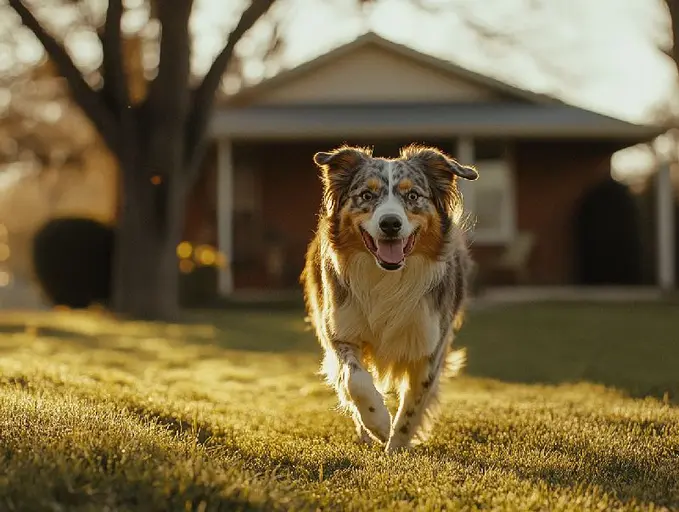The Ultimate Guide to Australian Shepherds: A Herding Breed for Active Families

Brief Introduction
The Australian Shepherd, often affectionately called an “Aussie,” is a medium-sized herding dog known for its intelligence, striking appearance, and boundless energy. This breed is a captivating combination of athleticism and brains, making it a popular choice for active families and individuals who enjoy outdoor adventures. With their mesmerizing eyes (often blue, brown, or a combination), distinctive coat patterns, and unwavering loyalty, Australian Shepherds have captured the hearts of dog lovers worldwide. They are wonderful family companion dogs, but it’s important to understand their needs before bringing one home.
Breed History
Despite their name, the Australian Shepherd didn’t actually originate in Australia. Their history is a bit more complex and rooted in the American West. Here’s a brief overview:
Origins in the American West
The breed’s development primarily took place in the United States, particularly in the western states. They are thought to have descended from various herding dogs brought to America by Basque shepherds who migrated from Europe (often via Australia, hence the name association) to work on large sheep ranches.
Role in Herding and Ranching
The Australian Shepherd was primarily bred for herding livestock, particularly sheep and cattle. Their agility, intelligence, and stamina made them invaluable assets to ranchers. They were capable of working long hours in challenging terrain, responding quickly to commands, and protecting livestock from predators. Herding dog breeds are essential for efficient farm management.
Formal Recognition and Breed Development
Over time, breeders focused on refining the breed’s characteristics, selecting for intelligence, herding ability, and a consistent temperament. The Australian Shepherd Club of America (ASCA) was formed in 1957, and the breed was officially recognized by the American Kennel Club (AKC) in 1991.
Appearance
The Australian Shepherd is a visually striking breed with a unique combination of physical attributes. Their appearance reflects their working dog heritage, emphasizing athleticism, agility, and endurance.
Height and Weight
* Males typically stand between 20 and 23 inches tall at the shoulder. * Females are slightly smaller, ranging from 18 to 21 inches in height. * Weight generally ranges from 40 to 65 pounds.
Coat
The Australian Shepherd boasts a medium-length, double coat that provides protection from the elements. The outer coat is moderately coarse, while the undercoat is soft and dense. The coat can be straight or slightly wavy. The breed comes in a variety of stunning colors:
- Black
- Red
- Blue Merle (a marbled pattern of black and gray)
- Red Merle (a marbled pattern of red and liver)
All of these colors can occur with or without white markings and/or copper (tan) points. The presence of the merle coat pattern is a defining characteristic for many.
Ears
The ears are triangular and set high on the head. They may be naturally dropped or partially pricked. The ears should be proportionate to the head size and not overly large or floppy. Ear shape and size contributes to their distinctive appearance.
Eyes
Perhaps the most captivating feature of the Australian Shepherd is their expressive eyes. They can be brown, blue, one of each (heterochromia), or marbled (having flecks of different colors within the same eye). The eye color often complements the coat color, creating a striking visual contrast. These dog breeds with blue eyes are particularly popular.
Tail
Traditionally, Australian shepherds often have naturally short or bobbed tails. However, tails that are not naturally short are typically docked. The AKC breed standard allows for both naturally bobbed and docked tails.
Character and Behavior
Understanding the Australian Shepherd’s temperament and behavior is essential for determining if this breed is the right fit for your lifestyle. They are known for their intelligence, energy, and strong herding instincts.
Attitude Towards People
Australian Shepherds are generally loyal and devoted to their families. They can be reserved with strangers initially, but they are not typically aggressive. Early socialization is crucial to ensure they develop into well-adjusted adults who are comfortable around new people.
Attitude Towards Children
With proper socialization and training, Australian Shepherds can be excellent family dogs and are gentle with children. However, their herding instincts may lead them to “herd” children by gently nipping at their heels. This behavior should be addressed through training to ensure it doesn’t become problematic. Supervision is always recommended when dogs and children are together. Dog breeds get along with children with proper training.
Attitude Towards Animals
Australian Shepherds can coexist peacefully with other dogs and cats, especially if they are raised together from a young age. However, their herding instincts may be triggered by smaller animals, such as birds or rodents. Careful introductions and supervision are essential to prevent any potential conflicts.
Activity Level
This is a high-energy breed that requires a significant amount of exercise to stay happy and healthy. They need at least an hour or two of exercise each day, which can include activities such as running, hiking, swimming, playing fetch, or participating in dog sports like agility or frisbee. A bored Australian Shepherd will often become destructive or develop behavioral problems. They thrive on having a job to do. High energy dog breeds need active owners.
Trainability
Australian Shepherds are highly intelligent and eager to please, which makes them relatively easy to train. They excel in obedience training, agility, and other dog sports. Positive reinforcement methods, such as rewarding good behavior with treats and praise, are the most effective. Consistency and patience are key to success. Easy to train dog breeds benefit from consistent training.
Breed Characteristics
- Intelligence: Exceptionally intelligent and quick learners.
- Energy: High energy levels require significant exercise and mental stimulation.
- Loyalty: Devoted to their families and protective of their home.
- Herding instincts: Strong herding instincts that can be channeled into positive activities.
- Playfulness: Enjoy playing games and interacting with their owners.

Care and Maintenance
Providing proper care and maintenance is essential to ensure the health and well-being of your Australian Shepherd. This includes attention to their grooming needs, exercise requirements, diet, and potential health concerns.
Care Features
- Grooming: Regular grooming is essential to maintain their coat. Brush them several times a week to prevent matting and tangles. During shedding season (spring and fall), daily brushing is recommended.
- Exercise: As mentioned earlier, Australian Shepherds require a significant amount of exercise. Provide them with daily opportunities to run, play, and engage in mentally stimulating activities.
- Training: Consistent training is crucial for managing their energy and herding instincts. Enroll in obedience classes or engage in other dog sports to provide them with mental and physical challenges.
Exercise
Besides the daily walks it is important to provide them with the opportunity to run freely in a safe, enclosed area or participate in activities like:
- Agility: Popular dog agility courses
- Flyball
- Herding trials
- Frisbee competitions
- Swimming
Feeding
Feed your Australian Shepherd a high-quality dog food that is appropriate for their age, activity level, and overall health. Follow the feeding guidelines provided by the food manufacturer and adjust the amount as needed to maintain a healthy weight. Divide their daily food ration into two meals to prevent bloat. Best diet for dogs is a crucial factor in their health.
Whether a Haircut and / or Combing is Needed
While Australian Shepherds don’t typically require haircuts, regular combing is essential to prevent matting and remove loose hair. Pay particular attention to areas behind the ears, under the legs, and around the tail. Professional grooming may be necessary if they develop severe matting or tangles.
Health
Australian Shepherds are generally healthy dogs, but they are prone to certain genetic health conditions:
- Hip dysplasia: A condition that affects the hip joint, leading to pain and lameness.
- Elbow dysplasia: A similar condition affecting the elbow joint.
- Progressive retinal atrophy (PRA): A degenerative eye disease that can lead to blindness.
- Cataracts: Clouding of the lens of the eye.
- Collie eye anomaly (CEA): A genetic eye disease that can cause vision problems.
- Drug sensitivity (MDR1 gene mutation): Some Australian Shepherds carry a mutation in the MDR1 gene, which makes them sensitive to certain medications.
Regular veterinary checkups and genetic testing can help identify and manage these potential health problems. Importance of vet checkups cannot be overstated.
Possible Problems
- Excessive barking: Australian Shepherds may bark excessively if they are bored, anxious, or trying to alert their owners to something.
- Destructive behavior: Boredom or lack of exercise can lead to destructive behavior, such as chewing furniture or digging.
- Herding behavior: Their herding instincts may lead them to “herd” people or other animals, which can be problematic if not addressed through training.
- Separation anxiety: Some Australian Shepherds may develop separation anxiety if they are left alone for extended periods.
Breed Weaknesses
While Australian Shepherds are wonderful dogs, it’s important to be aware of their potential weaknesses:
Level of Aggression
Australian Shepherds are not typically aggressive, but they can be territorial and protective of their family and home. Early socialization and training can help minimize any potential aggression issues.
Loyalty
While their loyalty is a positive trait, it can also lead to possessiveness. They may become overly attached to one person in the family, which can cause problems if that person is not always available.
Specific Weaknesses
- High energy levels: Their high energy levels can be challenging for inactive owners.
- Herding instincts: Their herding instincts require careful management and training.
- Potential health problems: They are prone to certain genetic health conditions that require monitoring.
- Need for mental stimulation: They need a lot of mental stimulation to prevent boredom and destructive behavior.
Conclusion
The Australian Shepherd is a truly remarkable breed, known for its intelligence, athleticism, and unwavering loyalty. This breed is best suited for active individuals or families who can provide them with plenty of exercise, mental stimulation, and consistent training. Best dog breeds for families depends on individual needs. If you are prepared to meet the needs of this demanding breed, you will be rewarded with a devoted and intelligent companion. However, if you lead a sedentary lifestyle or are unable to commit to their high energy needs, an Australian Shepherd may not be the right choice for you. Consider carefully whether you can provide them with the attention and activity they require to thrive.
Frequently Asked Questions About Australian Shepherd
-
Are Australian Shepherds good family dogs?
With proper socialization and training, Australian Shepherds can be excellent family dogs and are often gentle with children. Early socialization and addressing their herding instincts are crucial.
-
How much exercise do Australian Shepherds need?
Australian Shepherds are high-energy dogs that require at least one to two hours of exercise each day. This can include running, hiking, swimming, playing fetch, or participating in dog sports.
-
Are Australian Shepherds easy to train?
Yes, Australian Shepherds are highly intelligent and eager to please, which makes them relatively easy to train. Positive reinforcement methods are the most effective, and consistency is key.
-
Do Australian Shepherds shed a lot?
Australian Shepherds have a double coat and shed moderately year-round. During shedding season (spring and fall), they shed more heavily and require daily brushing.
-
What are some common health problems in Australian Shepherds?
Common health problems in Australian Shepherds include hip dysplasia, elbow dysplasia, progressive retinal atrophy (PRA), cataracts, Collie eye anomaly (CEA), and drug sensitivity (MDR1 gene mutation).
-
Are Australian Shepherds aggressive?
Australian Shepherds are not typically aggressive, but they can be territorial and protective. Early socialization and training can help minimize any potential aggression issues.
-
What kind of coat do Australian Shepherds have?
Australian Shepherds have a medium-length, double coat that provides protection from the elements. The outer coat is moderately coarse, and the undercoat is soft and dense. It can be straight or slightly wavy.
-
Are Australian Shepherds good with other pets?
Australian Shepherds can coexist peacefully with other dogs and cats, especially if raised together from a young age. Their herding instincts may be triggered by smaller animals, so supervision is essential.
-
Why are they called Australian Shepherds if they’re from the US?
Despite their name, Australian Shepherds originated in the American West. They are thought to have descended from various herding dogs brought to America by Basque shepherds who migrated from Europe, often via Australia.
-
What kind of food should I feed my Australian Shepherd?
Feed your Australian Shepherd a high-quality dog food that is appropriate for their age, activity level, and overall health. Follow the feeding guidelines provided by the food manufacturer and divide their daily ration into two meals.

